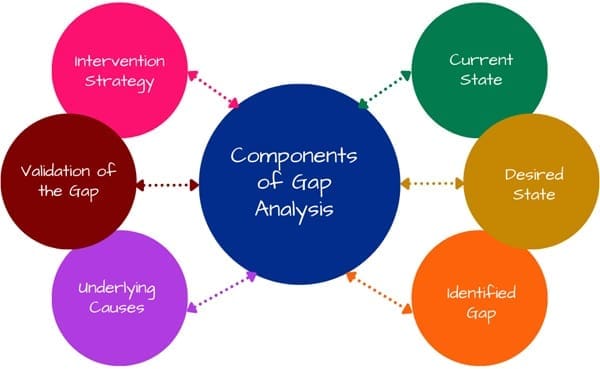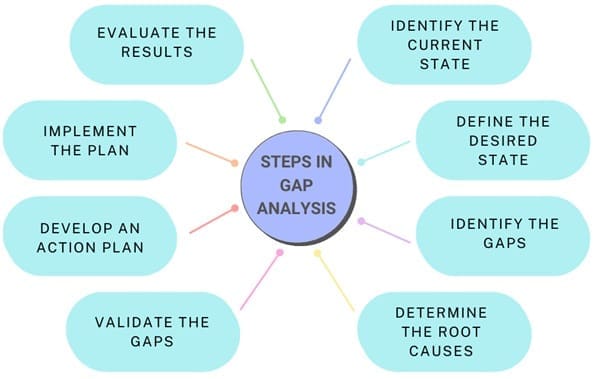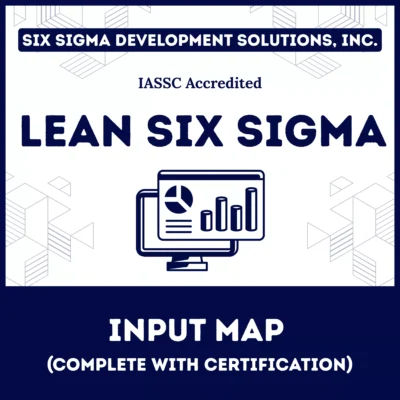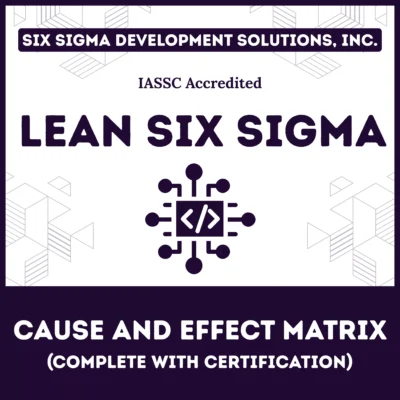Gap analysis is a strategic tool used to assess the difference between current conditions and desired outcomes in any given area. This analytical process helps organizations and individuals identify gaps in knowledge, skills, processes, or practices, providing a structured pathway for improvement and development.
While similar to a needs assessment, gap analysis offers a more standardized approach, focusing not only on the need but also on the strategic methods to address that need.
Table of contents
Definition of Gap Analysis
At its core, a gap analysis involves comparing the current state of a process, system, or knowledge base with the desired or optimal state. The “gap” is the difference between where you are now and where you want to be. This discrepancy highlights the areas that need improvement, whether it involves enhancing knowledge, upgrading skills, or changing practices to meet best practice standards.
For instance, in a healthcare setting, people use gap analysis to compare current patient care practices with the industry’s best practices. The difference between these practices would identify areas for improvement, guiding educational interventions or policy changes.
Purpose
The primary purpose of gap analysis is to justify the need for an intervention, such as an educational activity or a process improvement. It helps in the selection of appropriate teaching and evaluation methods by pinpointing the exact areas where there is a deficiency.
Organizations identify these gaps and focus on specific areas that need attention, ensuring they use resources effectively to achieve the desired outcome.
In the context of continuing education, particularly in professional fields like healthcare, gap analysis serves as the foundation for curriculum design. It helps educators determine the content, structure, and methods of instruction that will most effectively bridge the gap between current practice and the desired state.
Components

A thorough gap analysis consists of several key components, each contributing to a comprehensive understanding of the current and desired states:
- Current State: This involves a detailed assessment of what is currently happening. It includes the existing knowledge, skills, or practices within an organization or among individuals. This step is crucial as it establishes the baseline from which improvement will be measured.
- Desired State: The desired state represents the ideal situation or best practice. It’s what the organization or individual is striving to achieve. This could be based on industry standards, regulatory requirements, or the latest research in the field.
- Identified Gap: The identified gap is the difference between the current state and the desired state. It highlights the areas that need improvement. This gap could be due to a lack of knowledge, insufficient skills, or outdated practices.
- Underlying Causes: Understanding why the gap exists is critical for determining how to address it. This involves identifying the root causes of the gap, which could include lack of training, poor communication, inadequate resources, or systemic issues.
- Validation of the Gap: It’s important to validate that the identified gap is real and significant. This could involve collecting evidence such as performance data, feedback from stakeholders, or benchmarking against best practices.
- Intervention Strategy: Once the gap is identified and validated, the next step is to determine how to address it. This could involve designing educational programs, revising policies, or implementing new processes. The chosen intervention should be tailored to the specific gap identified.
Types of Gaps in Professional Practice

Gap analysis often focuses on three primary types of gaps in professional practice:
- Knowledge Gap: This occurs when there is a deficiency in understanding or awareness. For example, healthcare professionals might not be aware of the latest treatment guidelines, leading to outdated practices. Addressing a knowledge gap typically involves educational interventions such as lectures, readings, or online courses.
- Skills Gap: A skills gap arises when individuals cannot apply knowledge in a practical setting. For example, a healthcare provider may understand a procedure in theory but not have the hands-on experience to perform it effectively. Addressing a skills gap often requires hands-on training, simulations, or workshops.
- Practice Gap: This gap occurs when there is a disconnect between knowledge and actual practice. For instance, healthcare professionals might know the best practices but fail to implement them consistently in their work. Organizations may change processes, policies, or culture to address a practice gap and ensure that best practices are followed.
Process of Conducting Gap Analysis

Conducting a gap analysis involves a systematic approach, typically following these steps:
- Identify the Current State: Begin by thoroughly documenting the current situation. This could involve collecting data, reviewing current practices, and consulting with stakeholders to understand what is currently happening.
- Define the Desired State: Next, determine what the ideal situation would look like. This could involve referencing best practices, industry standards, or regulatory requirements. The desired state should be clearly defined and achievable.
- Identify the Gaps: Compare the current state to the desired state and identify where the differences lie. These gaps highlight the areas that need improvement.
- Determine the Root Causes: Investigate why these gaps exist. This might involve analyzing internal processes, assessing resource allocation, or gathering feedback from those involved. Understanding the root causes is crucial for developing effective solutions.
- Validate the Gaps: Ensure that the identified gaps are real and significant. This might involve gathering additional data, consulting with experts, or benchmarking against industry standards.
- Develop an Action Plan: Based on the identified gaps and their root causes, develop a strategy to address them. This could involve creating an educational program, revising policies, or implementing new processes. The action plan should include specific steps, timelines, and responsible parties.
- Implement the Plan: Put the action plan into practice. This could involve training sessions, policy changes, or process improvements. It’s important to monitor the implementation to ensure it’s proceeding as planned.
- Evaluate the Results: After the intervention has been implemented, evaluate its effectiveness. This could involve collecting feedback, reviewing performance data, or conducting follow-up assessments. The goal is to determine whether the gap has been successfully closed.
Practical Application of Gap Analysis
Gap analysis is a flexible tool that people use in many areas like healthcare, education, business, and manufacturing. Here are some examples of how gap analysis is used in different fields:
- Healthcare: In healthcare, gap analysis compares current patient care practices with the latest clinical guidelines. It shows where improvements are needed, such as updating treatment methods or giving extra training to healthcare providers.
- Education: In schools, gap analysis checks the difference between what students know and the goals of the course. This helps teachers see where more teaching or resources are needed.
- Business: In business, gap analysis compares current performance with industry standards. It shows where the business is falling behind and helps create plans to boost efficiency, productivity, or customer satisfaction.
- Manufacturing: In manufacturing, gap analysis compares current production methods with best practices. It helps find inefficiencies, cut waste, and improve product quality.
Gap Analysis in Program Planning
Gap analysis is particularly important in program planning, where it serves as a foundational step in designing educational interventions or improvement initiatives. By identifying gaps in knowledge, skills, or practices, program planners can tailor their efforts to address the most pressing needs.
For example, in continuing medical education (CME), a gap analysis might reveal that healthcare providers are not up to date on the latest treatment guidelines for a particular condition. This could lead to the development of a CME program focused on educating providers about these guidelines and how to implement them in practice.
The results of the gap analysis can also inform the selection of teaching methods and assessment techniques. For instance, if the gap is related to knowledge, the program might focus on lectures and readings, with quizzes and tests used to assess learning.
If the gap is related to skills, the program might include hands-on training or simulations, with assessments based on observed performance.
Challenges and Considerations in Conducting Gap Analysis
While gap analysis is a powerful tool, it’s not without its challenges. One of the main challenges is ensuring that the gap is accurately identified and that the root causes are correctly understood. This requires thorough data collection and analysis, as well as input from a wide range of stakeholders.
Another challenge is ensuring that the action plan developed to address the gap is realistic and achievable. It’s important to consider factors such as available resources, organizational culture, and potential barriers when developing the plan.
Additionally, gap analysis can be time-consuming and resource-intensive. It requires careful planning and coordination, particularly when involving multiple stakeholders or departments. A well-conducted gap analysis often provides more benefits than challenges, as it gives a clear roadmap for improvement and ensures effective use of resources.
Final Words
Gap analysis is an essential tool for identifying and addressing deficiencies in knowledge, skills, practices, or processes.
By comparing the current state with the desired state, organizations can pinpoint areas that need improvement and develop targeted strategies to close the gap. People use gap analysis in healthcare, education, business, and manufacturing to provide a structured approach to continuous improvement, ensuring that they focus efforts on the most significant needs.
Through careful planning, data collection, and analysis, gap analysis can lead to meaningful and sustainable improvements, ultimately helping organizations achieve their goals and fulfil their missions.


















